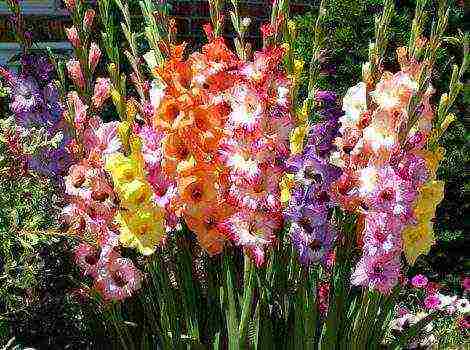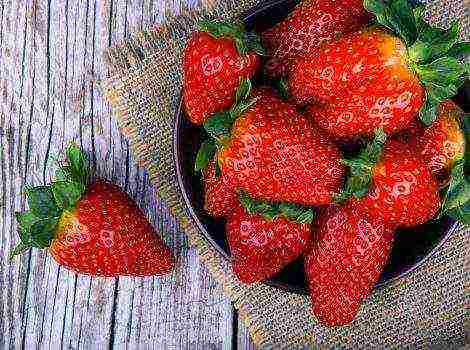Content
There are many varieties of basil. They differ in plant height, color, aroma, care and other indicators. The best basil varieties are grown commercially all over the world, they are profitable for sale and have excellent commercial qualities. They are also popular for growing in the garden or even indoors.
Basil classification by plant height
Depending on the height of the plant, this culture is undersized, medium-sized and tall. Moreover, in each individual case, the varieties of basil may have their own characteristics.
- Low-growing varieties are recommended for indoor cultivation in pots. There are practically no problems with them, they grow quickly, by themselves, you just need to water and harvest on time. The maximum growth of such varieties is 30 cm.
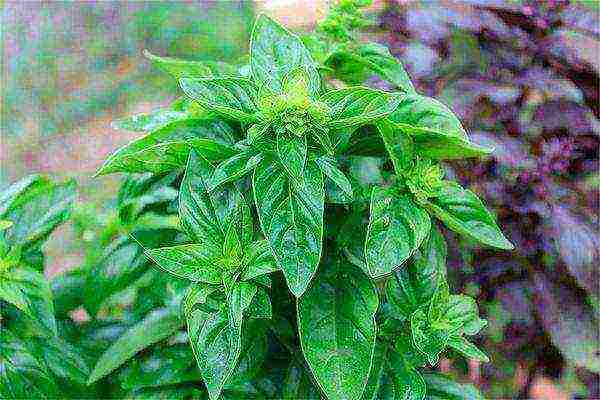
Green basil, aka sweet basil
- Medium-sized varieties are recommended for cultivation on private backyards and on an industrial scale. This is a versatile variety, convenient and not problematic to grow. The growth of such plants is from 31 to 60 cm.
- Tall varieties are difficult to grow. Even the treatment against pests will be laborious, because the higher the plant, the more difficult it is to care for it. They grow from 61 cm and above.
Classification of basil varieties by leaf color
Depending on the color of the leaves, basil varieties are divided into green and purple.
- Green basil, aka sweet basil, as it was called in ancient times. Widespread from Mediterranean countries. It is used in the preparation of various dishes. It has a delicate aroma and taste. At the same time, the saturation of green can be different, there are varieties with dark green leaves and light green ones. These include "Genoese", "Eugenol", "Sandwich", "Broadleaf", "Lemon aroma", "Cinnamon aroma", "Lemon", "Velvet", etc.
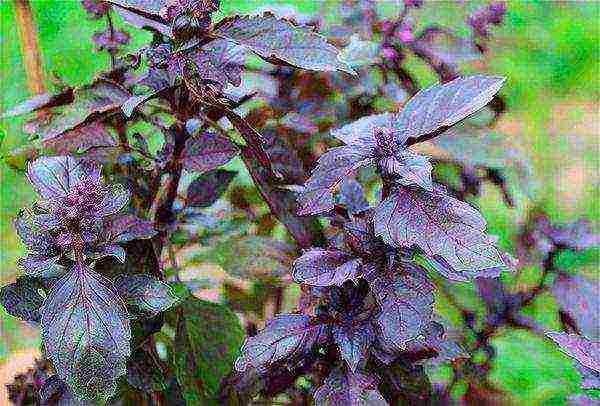
Purple basil has a pungent taste and aroma
- Purple basil has a pungent taste and aroma, so you need to use it very carefully in cooking. The leaves and the plant itself have a rich or light purple color. It contains about 1.5-2 times more essential oils than the green variety. It spread throughout the world from South Asia, now it is also popular in Europe and America. Purple varieties of basil include: "Yerevan", "Violet Vitaminchik", "Common Basil", "Dark Opal", "Anise",
The best clove and clove-pepper varieties
The clove and clove-pepper varieties of basil are widespread. They can be counted among the classic ones, as they grow almost everywhere, easy to care for.
- "Clove" - basil, growing in a compact, dense bush up to 60 cm in height, has bright green leaves.It can be grown throughout the year on the windowsill of the house or seasonally in flower beds. Has a pleasant clove scent.
- "Clove aroma" - has a very pronounced clove aroma, so it is often put in pickles instead of cloves. The variety is medium early, grows up to 25 cm in height, the leaves are green. The use is universal. Can be grown outdoors or in pots, at home.

The best clove and clove-pepper varieties
- "Basil eugenol" grows only in southern countries (South Africa). The leaves are large, green. This type of basil has a clove-peppery smell, but there are notes of lemon and mint. It can be bitter, used for meat and first courses, preservation, marinades. The plant grows up to 1 meter.
- "Common basil" has a strong clove-peppery aroma. It grows up to 60 cm, it is not whimsical to care for, the leaves are dark purple. Can be grown on a windowsill. It can be used fresh and dry for salads, seasoning for first and second courses, preservation, marinades.
- "Dark opal" or "Red", as it is popularly called. It has a very rich, pronounced clove-pepper aroma, for which it is appreciated all over the world. The leaves are red-purple. Fresh leaves can be put in salads, and dry leaves can be used to flavor oils, vinegar, pickles.
- "Holy Basil" or "Tulasi" has a pungent aroma of cloves and peppers. The taste can also be harsh and bitter. The color of the plant is purple. This variety is very popular in India, it is put there in almost all spicy dishes, it is also considered sacred, therefore it is often used for rituals and ceremonies.
Also, this category should include the following varieties: "Greek", "Sandwich Leaf", "Dark Night", "Stella", "Dreams of the Sultan", "Darkie". "Perfection", "Marquis", "Basilisk".
Pepper varieties of basil
Pepper basil varieties have a faint to bright peppery aroma. They are used primarily as a condiment for any food other than sweets or drinks.
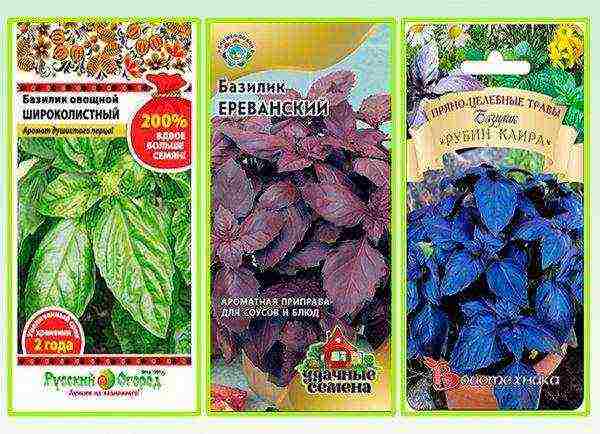
Pepper varieties of basil
- "Basil broadleaf" it has large, green leaves and high yield. Up to 250 g of greens can be harvested from one bush. Allspice aroma. It is used in cooking (salads, marinades) and cosmetology, as it contains a lot of essential oils.
- "Yerevan" - ranks second in prevalence. Has a high yield. The taste is tart, the aroma is fragrant, peppery. The use is universal. The leaves are dark purple, beautiful, can be grown as an ornamental plant.
- Ruby Cairo differs in black-purple color of the leaves, it can be an excellent decor for any flower bed and garden. It grows up to 30 cm, grown mainly in indoor pots on the windowsill. The aroma is pronounced, the taste is burning. Can be dried and frozen - aroma and taste are not lost during processing.
Also, it is worth counting here: "Aramis", "Campatto", "Ruby", "Rosie", etc.
The best aniseed basil varieties
Anise varieties of basil can be safely called unusual. Combinations of such a smell and taste are appreciated by gourmets and culinary experts all over the world, so such varieties can often be found on market counters.
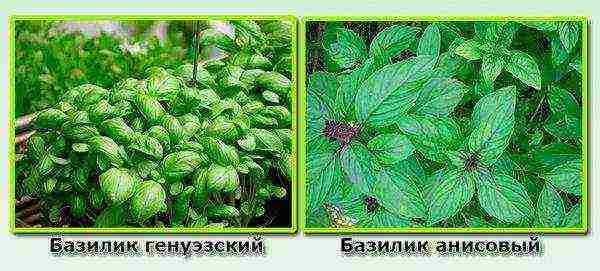
The best aniseed basil varieties
- "Italian Basil" or "Genoese" has a strong aniseed aroma that enhances the flavor of any dish. It is this type that is always used in the preparation of the well-known pesto sauce, as well as many others that were invented in Italy. It is used in cooking in any form for drinks, first and second courses, snacks. Can be grown on a windowsill. It grows short, has beautiful green leaves.
- "Anise basil" - a fragrant variety growing up to 40 cm. Leaves, stems and inflorescences are purple, with a silver tint. It can be grown in the garden or in the apartment, in pots on the windowsill or on the balcony.
This category also includes "Anise Gourmet", "Anise Delight", etc.
What varieties are lemon and menthol?
Lemon basil varieties are most often used to make interesting drinks.
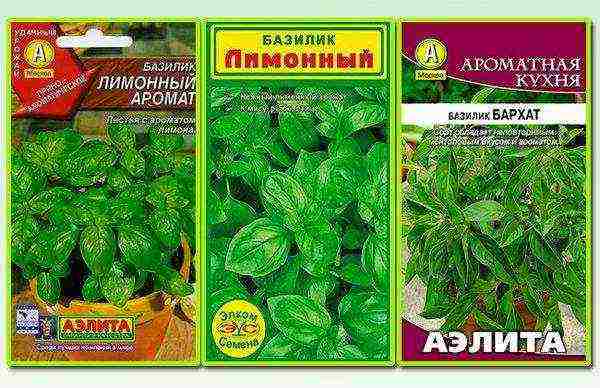
Lemon and menthol varieties
- "Lemon flavor" has a bright, rich lemon aroma. Grows in a bush of medium density. Up to 250 g of leaves of a light green color are collected from each plant per season. This variety is used to add a lemon flavor to dishes, as a decoration for desserts and salads.
- "Citric" Basil has a camphor aroma, but its taste is purely lemon, so it is often put in salads, desserts, main dishes to give them a pleasant sourness. It grows up to 35 cm, can be grown on a windowsill, the leaves are elongated, small, in comparison with other types, green.
- "Velvet" has a pleasant, menthol aroma and taste. It grows up to 30 cm. It is used in marinades, for flavoring or enhancing the flavors of drinks, seasonings, sauces, fresh and dried oils. The leaves are elongated, green, the flowers are pale pink.
What varieties can be used for baked goods and desserts?
Pastries, desserts and drinks are the main area for consuming basil varieties with caramel, cinnamon and vanilla aromas.

Varieties for baked goods and desserts
- "Caramel" - early look with a delicate fruity-caramel scent. Used simply as a seasoning to add a fruity caramel flavor to the dish. It grows not as a tall bush, it is grown mainly in apartments.
- "Vanilla aroma" - a tall variety with juicy, purple leaves when fully ripe. Vanilla flavor and aroma. Can be grown indoors, in greenhouses or outdoors. It is usually used as an additive in confectionery.
- "Scent of cinnamon" grows up to 40 cm, leaves are green. Up to 400 g of leaves are collected from the plant. The aroma and taste are cinnamon. Used for baking, desserts, marinades.
Also for baking, you can use the varieties of basil "Cinnamon", "Pet", "Malachite".
What varieties are suitable for marinades?
Basil varieties for marinades are distinguished by a rich fragrant aroma, do not lose taste and smell for a long time, and can be heat treated.
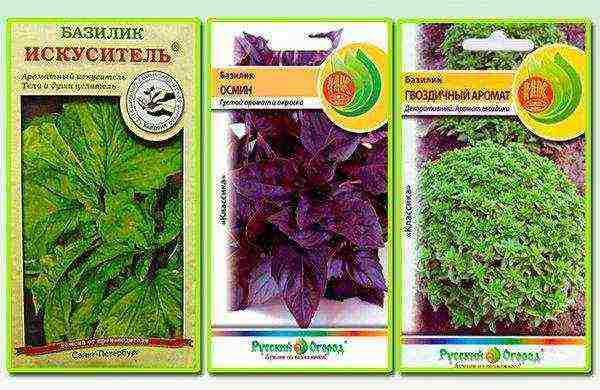
Basil varieties for pickles
- "Tempter" - a sort of basil bred specifically for marinades. Its leaves are green, large. The aroma is sharp, so small doses should be measured into the marinade, but during the marinating the smell does not disappear. Can be used fresh and dried.
- "Osmin" especially recommended for marinades, due to its rich, rich aroma and unobtrusive taste. Grows as a cultivated or ornamental plant. Its homeland is India, but not so long ago, this variety won the love of Americans and Europeans. This is a very thermophilic plant, therefore it is grown either in southern countries, or in pots on a windowsill on the sunny side.
The varieties "Clove aroma", "Ruby of Cairo", "Italian", "Eugenol", "Shirokolistny" described above can also be included here.
VIDEO - Casting results for the best sort of basil
Of the two hundred types of basil in culture, no more than ten are grown - essential oil and decorative forms are used. This culture also pleases with its varietal variety.
Basil: varieties and types
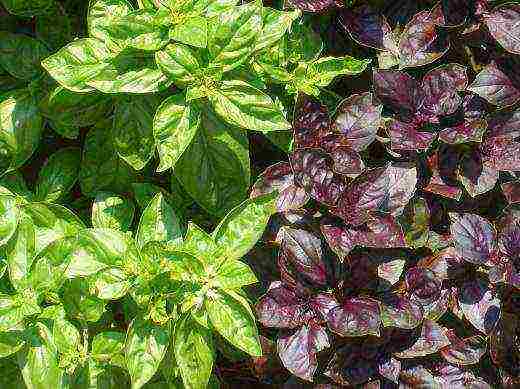
Basil varieties
Four forms of basil are grown in culture:
• Large
• Small
• Ship-shaped
• Tufted
The following varieties have been used:
• Camphor (fragrant) basil - the height of this plant is about half a meter. The leaves have a tart taste and clove aroma.
• Mexican basil (cinnamon) reaches a height of about half a meter. The leaves have a characteristic cinnamon aroma. The flowers of this basil are purple.
• Violet basil (common or regan) is a plant with large red-violet leaves that have a tart aroma and a rather delicate taste.
• Lemon basil gives a rich harvest of greens with a pleasant lemon aroma (each bush allows you to get about 250 g of greens).
The best varieties of purple basil
Violet basil varieties are quite popular. This category includes Moskvoretsky Semko, Thai Queen, Purple (Dark Opal), Moorish, Table.
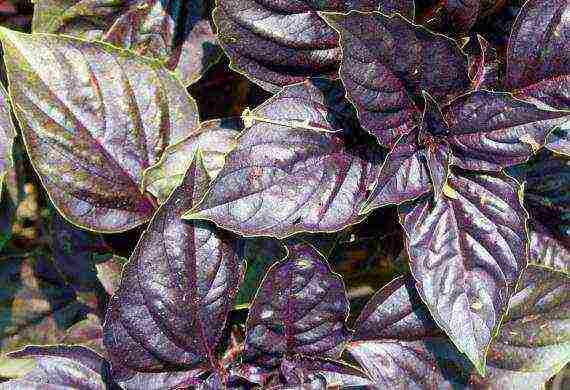
Basil Variety Purple
Basil variety Purple (Dark opal) has beautiful dark purple leaves. A characteristic feature of the variety is a very pleasant taste and clove-pepper aroma of greens. This plant is used to flavor vinegar, sauce, oil.
Green Basil Varieties
Green basil is quite common. This group is represented by the varieties Tonus, Smal Levels, Green cornflower, Genova, Stella, Zastolny, Fantazer.
The Balconstar variety is very popular. Small leaves have a delicate taste and pleasant aroma. Greens are used in salads. The variety is undersized - plants can be grown in pots on windowsills.
The best varieties of basil for the windowsill
Basil is not only a spicy but also an ornamental plant. It is quite possible to settle it on your windowsill. The most suitable varieties: Pepper, Troll, Curly, Dwarf, Marquis, Broadleaf, Clove, Philosopher.

Basil variety Dwarf
The Dwarf variety, as the name implies, has a small height - no more than 10-18 cm.The leaves can be both green and purple. They have a pleasant aroma and delicate taste. Plants look beautiful in pots.
Basil varieties by ripening time
Early and mid-early basil can be cut 35-65 days after germination. The best early varieties: Pearl of the Moscow Region, Clove, Green fragrant, Dwarf, Lemon.

Basil variety Basilisk
Plants of the Basilisk variety reach a height of 18-20 cm. The small leaves of this early basil are colored green and have a peppery-clove aroma.
From the emergence of seedlings to the achievement of technical maturity of medium, medium-late and late varieties, 65-90 days pass. Mid-season varieties: Charodey, Moskvoretsky Semko, Caramel.
The mid-season Orion variety has small bluish-green leaves with dark veins. The greens have a strong peppery aroma.
Medium and late varieties: Fantasy, Zastolny, Sharm, Moorish, Marquis.
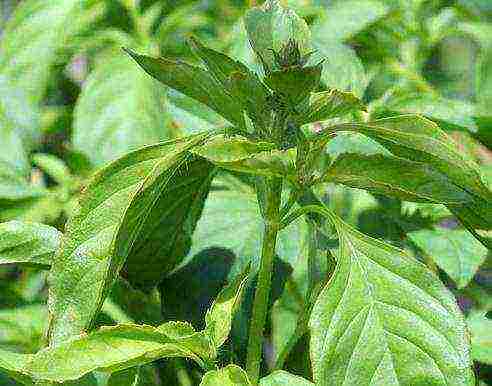
Basil variety Lemon
Lemon - medium late basil with large, green, smooth leaves. The plant has a pleasant citrus aroma.
Basil varieties for central Russia and the Moscow region
In the conditions of central Russia, basil can be grown through seedlings. The best varieties: Aniskin, Ararat, Velvet, Violet, Valya, Greek, Dragon, Yerevan, Gigolo, Green fragrant, Orion, Pepper flavor, Robin Hood, Russian giant purple.
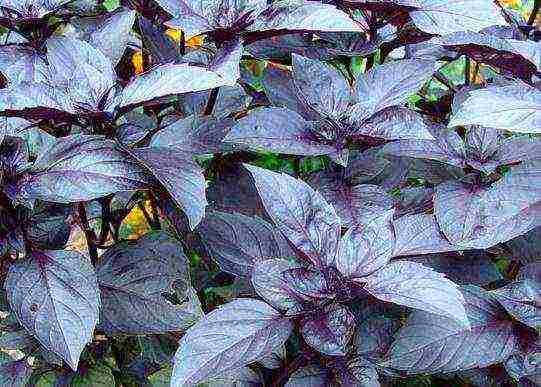
Basil variety Vanilla aroma
Vanilla aroma is another successful variety for central Russia. It is characterized by mid-early ripening periods. The plant is short. The leaves are purple with a delicate vanilla aroma. The plant tolerates a lack of sunlight well.
The best varieties of basil for the Urals
For the weather conditions of the Urals, varieties of the Caucasian and Russian selection are suitable (there are no varieties zoned specifically for this region). The most popular varieties: Anise aroma, Ararat, Baku, Basilisk, Clove, Yerevan, Tempter, Caramel, Lemon, Charodey.

Basil Variety Sharm
The height of the mid-season Charm Basil is about 65-70 cm. The bushes are compact, the leaves are large, very dark, with a strong aroma and purple pigmentation.
The best basil varieties have a pleasant aroma - perceptible, but not harsh. Plants can vary in color and height. They also differ in terms of ripening - everyone can choose a variety that ideally matches the requirements of a particular region.
Basil (lat. Ócimum) is a fragrant plant belonging to the flowering department, the dicotyledonous class, the order of the luciferous, the family of the lacustrine, the genus basil.
A native of Asia, spicy basil (translated from Greek means "royal, royal") has conquered the countries of Europe with its many-sided aroma. Today, this strong-smelling plant is grown by many gardeners, and true gourmets cannot imagine many luxurious culinary dishes without the most fragrant leaves of this spice.
back to contents ↑ Description of the Basilica.
Basil's tetrahedral stems reach a height of 30 to 60 cm. Wild species grow to a height of 70 cm. Basil leaves are green or purple-burgundy and oblong-ovoid. At the end of the stems there are inflorescences, which consist of several flowers. Basil flower can be of different shades: from white and pink to white-purple. Basil plant usually blooms from July to September. The cups, stems and leaves of the basil are rough to the touch. It is in them that the glands that accumulate the essential oil are located: it gives the basil a pleasant spicy aroma. The plant also contains acidic saponin, tannins, carotene and other useful substances.
back to content ↑ Types and varieties of basil, names and photos.
There are about 70 types of basil. Each differs from each other visually: the bushes can reach different heights, the leaves differ in color and shape. There are types of basil with small leaves, while others have wide, and sometimes corrugated leaves.
The most popular types of basil are lemon, purple, cinnamon, allspice, and common basil. In different countries and cultures, one species is valued more than another.
- Sweet or camphor basil, ordinary... A highly branched plant with a large deciduous mass and a bush height of 55-70 cm. The stem and leaves are pubescent, have a mild peppery aroma. Among the varieties are known: "Fragrant handsome", "Magic of the East", "Ararat".
- Basil purple... An annual plant, up to 50 cm high. It got its name from its bright purple leaves. This species has a more pronounced, strong aroma than its green-leaved counterparts, is very much loved in the traditions of Asian and Caucasian cuisines. Such varieties of purple basil as "Purple", "Moorish", "Zastolny", "Moskvoretsky" are very tasty and fragrant.
- Basil green... The bushes of this variety have light green leaves, some varieties have pubescence on the stem and leaves. The height of the bush is 35-45 cm. The aroma varies depending on the variety, but is less intense than that of purple basil. Popular varieties: "Green cornflower", "Tonus", "Favorite", "Explosion".
- Cinnamon basil... A plant with bright green, shiny leaves and lilac flowers. The height of the bush reaches 45-60 cm. All parts of the plant have a pronounced aroma of cinnamon with a light mint note and a slightly burning aftertaste. The varieties "Cinnamon", "Wonderful", "Gentle early" are very much appreciated.
- Lemon basil... The plant is notable for its short stature - up to 35 cm, the leaves are pale green, with a piquant lemon scent mixed with the tart smell of camphor. Gardeners' favorite varieties are "Moscow Bogatyr", "Lemon", "Iskra", "Novinka".
- Black basil... All varieties of this species are distinguished by an unusual color: the stems and leaves are very dark in color, often turning from deep purple to glossy brown and even almost black. There are low-growing up to 30 cm and tall varieties, in which the bush reaches a height of 50-65 cm. Taste qualities are excellent, the aroma is strong, peppery, slightly pungent, lasts a long time when the greens dry. Popular varieties: "Bakinsky", "Ruby Cairo", "Osmin".
- Basil red... A plant with a branched stem, 20-35 cm high, with fragrant leaves of a red-lilac color, sometimes turning into a burgundy hue. The scent ranges from mild vanilla with a peppery note to strong camphor-clove. Actual varieties: "Zhuravlik", "Generous", "Eastern Guest".
back to contents ↑ History of the Basilica.
The basil plant has many names. It is called fragrant cornflower, rean, reikhon, odor or reagan. The taste and aroma of basil have been appreciated at all times. In India, the followers of Hinduism used it in their rituals, since they considered basil a sacred plant. And the ancient Greek authors described how it was used in medicine. The plant got to Europe only in the 16th century. Thanks to its aroma and taste, it began to be highly appreciated. Even after a long period of time after its appearance in Europe, basil has not lost its position in the cuisine of different countries.
However, during the great geographical discoveries and travels, when other spices began to enter Europe, the plant was pushed to second place.
back to contents ↑ Where does basil grow?
The tropical regions of Asia are considered the birthplace of the basilica. At the moment, the plant is very common in all countries of southern Europe. Different types of basil are grown in the Caucasus, India, Moldova, Egypt, Crimea and the Pacific islands. It was from these islands that it spread throughout Europe.
back to contents ↑ Basil: planting.
Despite its popularity, the southern visitor, basil is a capricious plant, and in order to achieve results when growing it, lovers of this spice will have to work hard.
- When to plant basil? The main thing to pay attention to is the time of planting of the thermophilic basil in the ground. If you do not plan to cultivate this crop in a greenhouse or greenhouse, please note: the optimum soil temperature for planting is 20-25 degrees. In the middle lane, it is recommended to sow or transplant basil seedlings into the ground in late May or early June, with full confidence that there is no longer a risk of recurrent frosts. The tender sprouts of basil absolutely cannot stand even the slightest cold snap.
- Planting basil in the ground. As for choosing a place for this fragrant plant, do not forget - basil prefers free sunny areas, with light soils without stagnant water. This fragrant culture will surely thank you with a lush bush with abundant green mass, if you properly prepare the soil substrate. Apply a couple of kilograms of good humus, peat and compost for every square meter of soil. Before planting the basil, it is advisable to spill the soil with a solution of the following components: for 5 liters of water - half a teaspoon of potassium sulfate, the same amount of potassium chloride and urea.
It is better to arrange basil seedlings in small beds, 80-100 cm in length, making a distance of 15-20 centimeters between seedlings. The optimal time for planting basil is in the late afternoon and on a cloudy but warm day, so that the plant does not burn the sun, and it goes through the rooting process more easily.
back to contents ↑ Basil care: watering and feeding.
Each planted bush should be watered with soft, settled water. In the future, basil requires watering every 3-5 days (this is at high temperatures and no rain), feeding once every 25-30 days with nitrogen fertilizer (nitrophoska is perfect - 2 tablespoons per 12 liters of water) and gentle, not too deep loosening soil near the bush. Want to maximize your green mass? Remove peduncles and tops of the bush two to three times during the growing season.
back to contents ↑ Diseases of Basil.
Basil is quite resistant to various diseases, but under unfavorable conditions, such as thickening of the planting, excessive watering, high humidity and low temperature in the greenhouse, fungal diseases can develop on it. The most common of them are black leg, fusarium, gray rot.
Preventive measures against basil diseases include the following measures:
- You should not grow a plant in the same place for more than 2 years;
- Watering should be moderate;
- The soil between the rows should be loosened and a crust should not be allowed to form;
- Immediately remove diseased plants together with a clod of earth.
At the earliest stage of the disease, the basil plant can be saved by spraying daily with an infusion of onion peels (brew 100 grams of onion peels with 400 grams of boiling water, leave for a day, then strain) or sprinkling it with a solution of copper sulfate (in a proportion of 2 liters of water: 1 tsp. vitriol).
back to contents ↑ Basil in the greenhouse.
Basil feels quite comfortable in a greenhouse. Most often, it is planted there in May, when the soil is already well warmed up and the threat of frost has passed. In a greenhouse, basil requires moderate watering, but the main thing is to ventilate it well: due to stagnation and poor air circulation in a closed greenhouse, this southern guest often falls ill.
back to contents ↑ Basil: growing from seeds.
Growing basil from seeds is a troublesome but possible option. Soak the seed in any growth stimulator for 7-10 hours (Epin is perfect). Then sow the seeds slightly dried on the fabric into the seedling boxes or directly into the open and prepared ground, covering the crops with polyethylene or agromaterial. Water the seeds in a timely manner, choosing the best approach - do not overdry or flood with water. Within 8-12 days, tiny shoots of this fragrant plant will begin to appear.
back to contents ↑ Basil: growing by cuttings.
Cutting basil is another, and, perhaps, the most problem-free method to "start" this fragrant greenery in your garden plot or in your home pot. True, you will have to get hold of a couple of twigs of an already adult basil. Cuttings are placed in water with a growth stimulant for about one and a half to two weeks. As soon as roots appear on them, they can be planted in open ground or rooted in a pot, not forgetting about regular feeding and watering.
back to content ↑ Growing basil at home.
Despite some capriciousness, basil is quite successfully grown on a windowsill in pots or boxes. Low-growing varieties are optimal for this type of cultivation, and the most favorable time for planting seeds, of course, is the spring months - March-April.
It is better to choose the capacity deeper - at least 20-30 cm in depth, because this plant will quickly turn into a bush. A drainage layer 1.5-2 cm thick must be laid on the bottom of the container, and only then the soil is poured. Ordinary garden soil enriched with mineral fertilizers is suitable, or you can use soil purchased in a specialized store marked "For vegetables and herbs." Please note: the ground must be warm before sowing seeds.
It is recommended to soak basil seeds for 20-25 hours in gauze moistened with a growth stimulant, for example, "Epin". Sowing basil is carried out in moist soil, not deeply - about 1 centimeter, it is advisable to make a distance of 6-7 cm between future plants.Then the container is covered with a polyethylene film and set in heat until the first sprouts appear, which are formed already on the fifth or seventh day.
Be sure to provide the gentle shoots of homemade basil with the optimal temperature - it should not be lower than 24-28 degrees, and also do not forget about regular watering with settled water. After the appearance of four to five pairs of leaves on the seedling, the top of the bush can be pinched: this will limit the growth of the plant in height, it will begin to bush abundantly and will not give flower stalks, directing all its strength to the formation of lush and fragrant foliage. Basil takes root very well, so it can be very easily grown at home from a cuttings cut from the top of an adult plant. Place the cutting 7-10 cm long in water, wait about a week for the roots to form on it, and boldly root the cutting in the pot.
Caring for the basil planted at home is easy: water it daily (especially if the container with the plant is on a sunny window), it is advisable to do this in the early morning hours, but do not overmoisten the ground. Do not forget to loosen the soil every 3-4 days - basil is very responsive to such a procedure, "treat" the plant with mineral fertilizing, regularly cut off the flower stalks that appear on the bushes if you want to get a powerful and abundant green mass. Do not forget that basil is "southerner", which means that it does not like drafts and low temperatures, preferring to bask in the sun: provide it with maximum light and protect it from the cold. If it is not possible to give the plant maximum light, additional artificial lighting should be arranged for the basil.
back to contents ↑ Collection and drying of basil. How to store basil?
Due to its chemical composition, the aroma of basil is somewhat reminiscent of cloves and nutmeg, and the taste of basil is slightly bitter and spicy. Basil leaves and stems are added to salads, pickles, soups, sausages and sauces.
You can collect the plant 2 times per season, including during flowering, that is, from July to September. The first collection of basil is carried out before flowering, at this time you need to cut off the leaves and shoots, leaving the lower leaves. With proper drying, the plant does not lose its color, taste and smell, while the dried leaves easily break or grind into powder.
For proper drying, it is enough to lay the basil in a thin layer in a well-ventilated shady place without direct sunlight.
You need to store basil in a glass or earthenware dish with an airtight lid; in this form, dried basil can be stored for 3-4 years.
back to content ↑ Basil: beneficial properties.
Basil is a very useful plant that contains vitamins C, B2, PP, ascorbic acid, provitamin A, sugar, carotene, P-rutin and phytoncides. The oil content in basil leaves reaches 1.5% - 2%. Basil essential oil also contains substances useful for humans: saponin, camphor, ocimene, cineole, methylchavinol, eugenol, estragol.
The benefit of basil lies in the fact that it is an immunostimulating agent, protects against viral, fungal and bacterial infections of the respiratory tract, including relieving the symptoms of bronchitis and asthma. It has antipyretic and diaphoretic effects, removes mucus from the nasal passages and lungs, improves digestion and absorption of nutrients, strengthens nerves, normalizes sleep, improves potency, stimulates mental activity and improves memory. The herb basil is used for flatulence, gastrointestinal ailments, lung diseases, and cancer. The plant also contains enzymes that not only help digestion, but also help burn fat in the body.
back to contents ↑ Basil: contraindications.
However, do not consume large amounts of basil as it can be harmful. The plant contains mercury compounds, so it is contraindicated for children under 7 years old and pregnant women, and the use of large amounts of basil can lead to poisoning even in a healthy person.
back to contents ↑ Interesting facts:
- In ancient Egypt, basil was used to embalm mummies;
- Hindus today rank basil as a sacred herb, taking it to courts to be sure of giving a plausible testimony;
- Italians-romantics made this plant a symbol of loyalty and love: a vase on the beloved's window, filled with basil stalks, means a hint of a date;
- In Romania, a young man who took a stalk of fragrant basil from the hands of a young person is a priori considered her fiancé.
Did you like the article? Share with your friends:
Since ancient times, people have been using spicy herbs as a vitamin seasoning for various dishes, and they prepare medicinal drugs from them.
These herbs include basil, the species and varieties of which are grown in many countries of the world for both culinary and medicinal purposes. Let's get acquainted with the main specific features and varietal assortment of this spice, and find out how they differ and how they look.
Description of Basil Plant Species
Basil - Ocimum
Other names: fragrant basil, common basil, camphor basil, mint-leaved basil, green aromatic basil.
A bushy or herbaceous plant from the Yasnotkov family. It happens perennial and annual.
It is translated from Greek as "king".
The plant blooms with an intermittent brush or spikelet. White, light pink or purple flowers are collected in whorls of 6-10 pieces.
The roots are superficial and branched, the stem is straight and branched, about 60-70 cm long.
The leaves, which have an ovoid oblong shape, are decorated with sparse denticles and pubescent with villi.
 Basil: types and varieties
Basil: types and varieties
Achenes remain viable for about five years.
Wild basil can be found in the South and Central Asian regions, India, China, Africa, Iran, the American tropics, and the Caucasus.
The well-known camphor oil is made just from the essential oils of basil. The leaves of the plant have a salty and tart taste, due to which they are added to meat and fish dishes, to pasta and cheeses.
The historical roots of the basilica
As the story goes, it first appeared in the Middle East and India. In ancient times, medicinal decoctions and infusions were made from it.
- In European countries, they learned about it thanks to the Germans, in whose country basil has been cultivated since the beginning of the 12th century.
- In the 16th century, the French and other Europeans began to add its greens to traditional dishes, especially meat, desserts, refreshing and warming drinks.
- In the 18th century, it also ended up in Russia, where this greenery was initially used as a medicine.
Basil is now cultivated all over the planet and is used mainly as a fragrant spice, rich in essential oils, vitamin C, PP and B2, as well as carotene, rutin, camphor, etc.
Basil green and purple: the difference
There are a great many varieties of this plant, but according to the color of the leaves, they are all divided into two types: purple and green. We will find out what their features are, and how green basil differs from purple.
Taste
Green basil has a mild flavor and is therefore commonly used in European cooking. They prepare many desserts with this plant, but the purple look is not suitable for them.
But the inhabitants of the Caucasus and Asian peoples give preference to the purple plant, appreciating its rich, tangy flavor.
Scent
Green basil exudes a delicate aroma, especially the lemon variety used in the production of refreshing drinks.
In contrast, purple basil, aka red basil or black basil (with black-purple leaves), has a sharper smell. It is enough to walk past a tray with this view in the market, and you will immediately feel the characteristic harsh smell.
By the way, this greenery is strongest, whether it is bush or herb basil, smells when it picks up color.
Leaf color
As can be seen from the names of the species, one of them has green leaves, the other has purple, purple-violet or black-violet.
These are, perhaps, all the differences between green and purple basil.
Green basil: photo
This is what the green-leafed spice plant looks like:
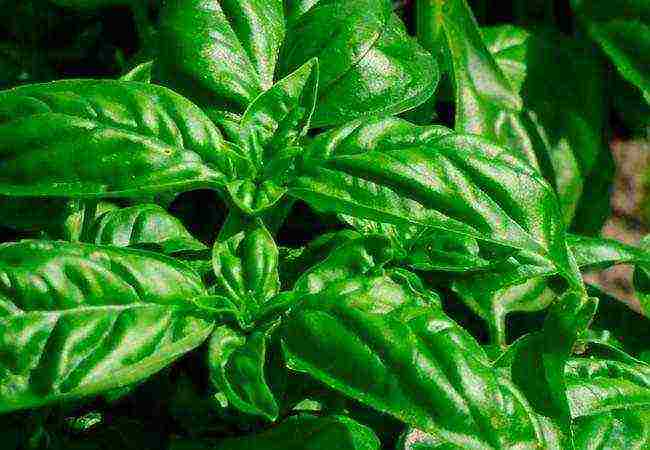 What makes green basil different
What makes green basil different
Basil purple: photo
And this is what a plant with purple leaves looks like:
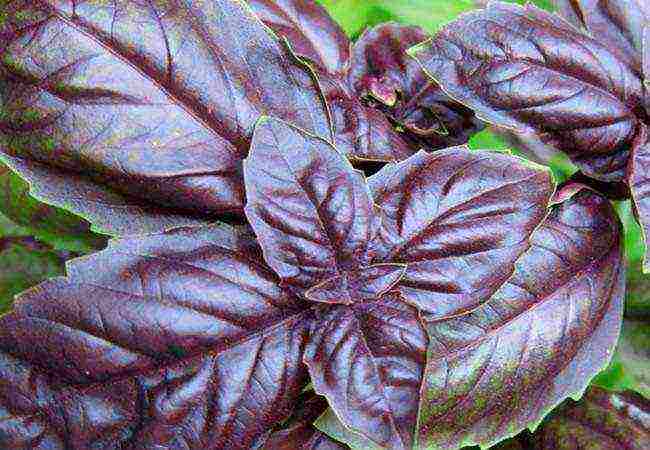 Basil green and purple difference
Basil green and purple difference
The best varieties of green basil
We will find out which varieties of the species with green leaves are popular with modern gardeners.
Basil "Basilisk"
An ornamental variety successfully grown both in vegetable gardens and in the house - in flower pots.
Plant up to 20 cm high with a rich head of smooth small leaves, blooming with white small flowers.Due to its peppery - clove aroma, it is used in marinades and fresh salads.
Up to 700 g of leaves can be harvested from 1 square meter. Leaves are ready for cutting in 2 months from the date of germination.
Basil "Clove"
A tall, bushy plant that can grow up to 60 cm, covered with elongated bright green leaves. It blooms in clusters of snow-white flowers.
It can be grown both in the garden and at home. For its characteristic smell and taste of cloves, it is an excellent seasoning for meat and salads.
Up to 2400 g of leaves can be harvested from 1 square meter. Clove basil is ready for cutting after 24-40 days from the date of germination.
Basil "Greek"
This small-leaved spherical bush 15 cm high is so beautiful that it can decorate any interior, not just a garden. Its sweetish spicy taste and classic basil aroma are highly revered by Italian cooks. They add Greek basil to sauces, marinades and fresh salads.
It is ready for cutting in 2-2.5 months from the moment of germination.
Basil "Lemon flavor"
A plant with a rich, refreshing lemon scent. From one bush of this variety, you can get up to 250 g of fresh smooth leaves of a light green color. They add a special flavor to desserts, vegetable salads, drinks and various dishes.
Up to 2900 g of leaves can be harvested from 1 square meter. Lemon basil can be cut after 2-2.5 months from the date of germination.
Basil "Gourmet"
Salad variety. Compact, low plant (up to 25 cm) with wide large leaves.
The variety is very aromatic and has a delicate taste. Grows back quickly after pruning. Good for adding to salads and pasta, it can be dried, pickled and frozen.
You can cut the leaves after 50 days from the moment of germination.
Basil "Caramel"
A favorite plant of culinary experts with a pronounced caramel-fruity taste, ready for cutting within a month after germination!
It can be grown both in the garden and on windowsills. The fleshy large leaves of caramelized basil are suitable for vegetable salads and other dishes, they can be canned and dried.
The yield of the plant is up to 3300 g per square meter, it is ready for the first cut after 30-40 days from the moment of emergence.
Thai Queen Basil
Ornamental plant with elongated large leaves contrasting with purple stems square on the cut.
Differs in luxurious bloom in the form of clusters of dark purple flowers, more reminiscent of lilac bloom. This variety can be grown in greenhouses, vegetable gardens, orchards and window sills.
The leaves are eaten throughout the growing season.
 The best varieties of green basil
The best varieties of green basil
Basil "Sacred"
He is also Indian basil, or Tulasi. The variety is grown in vegetable gardens, greenhouses and flower pots.
Its leaves exude a spicy-sharp clove-peppery smell, and have a bitter aftertaste, due to which they are used in spicy dishes.
Basil "Naughty"
A plant with small fragrant leaves with a delicate taste, forming a pretty bush with many shoots.
It is grown both in vegetable gardens and in homes - in flower pots and containers. It is used for preserving food, as a seasoning for meat, pasta, fish and fresh salads.
The yield of the Shalun variety is up to 1800 g per square meter.
Basil "Tonus"
Tall spicy plant. Leaves of medium size and bright green color have a tart pleasant taste and a delicate smell. They are used dried or fresh - in salads, drinks and various dishes.
Cutting is possible after 76 days from the moment of emergence.
The best varieties of purple basil
We will find out which varieties of purple basil are most often grown by summer residents and gardeners.
Basil "Thai"
Thai basil seeds produce compact plants with dark purple toothed smooth leaves that form a dense bush.
The leaves exude a pronounced spicy aroma with cinnamon notes. They are added to salads, marinades and pickles, meat and other dishes.
Basil "Yerevan"
One of the best culinary varieties. It builds up a bright deciduous mass of bright purple leaves with a reddish tint.
During flowering, the bushes are decorated with pale pink flowers, so this plant is often grown as flower beds. The variety is also good because the leaves can be cut 2-3 times per season.
The yield of the variety is 3-3.5 kg of leaves per 1 square meter.
Basil "Opal"
Popular variety with deep purple-violet leaves. It blooms with crimson flowers that need to be cut off so that flowering does not interfere with the growth of leaves.
The leaves have a pronounced peppery smell with clove notes and a tart pleasant taste. They are used in sauces, salads, vinegars, oils and various dishes.
Up to 2 kg of Opal basil leaves can be harvested from a square meter.
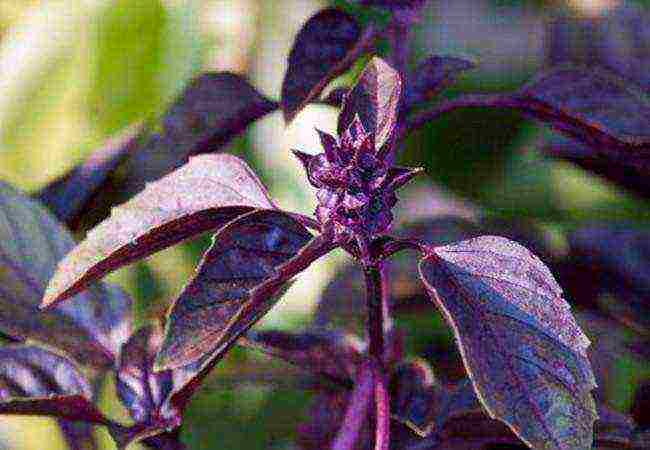 The best varieties of purple basil
The best varieties of purple basil
Basil "Pepper flavor"
An annual herbaceous plant with unusual reddish leaves. Vitamin leaves have a spicy aroma and taste, and therefore are often used by chefs instead of peppers when preparing sauces and various dishes.
The plant is ready for cutting after 20 days from germination. Its yield per square meter is up to 4200 g.
Basil "Ararat"
A very aromatic variety that forms tall, branching bushes with lilac flowers. Its green-purple leaves are rich in carotene and essential oils. They are added to tender cheeses, green salads and vegetable soups. They are sprinkled on ready meals before serving.
Leaves can be cut off after 2 - 2.5 months. Can be grown in flower pots.
Vanilla basil
An annual herbaceous basil variety with powerful branchy stems no more than 40 cm high.
The leaves are serrated, dark purple in color, flowers are pale purple, collected in spikelets. The leaves are so delicious that they are used not only in familiar dishes, but also in fruit salads.
Dishes with green basil
This herb has long been used by cheese makers in the manufacture of cheeses, and by culinary experts in vegetable salads, spicy soups such as gazpacho, meat and fish dishes. The French add green basil to sweets, the Italians to jams.
So that you can understand why Europeans value this spice, we suggest preparing the famous Italian salad with basil and mozzarella.
 Dishes with green basil
Dishes with green basil
Caprese salad
Ingredients for 4 servings
- Fresh tomatoes - 8 pcs.
- Green basil leaves - 1 tbsp + 2 sprigs for decoration
- Water - 2 tbsp. spoons
- Wine vinegar - 2 tbsp spoons
- Shallots - 1 pc.
- Salt - to your taste
- Mozzarella - 250 g
- Olive oil - 2 tablespoons spoons
- Oregano and black pepper - your choice.
How to make basil salad
To make Caprese salad, follow the step-by-step recipe:
- Cut the washed tomatoes and mozzarella into thin circles.
- Prepare the basil sauce: grind the basil leaves with peeled onions, water, salt and wine vinegar in a blender.
Wait 5 minutes for the sauce to sit and mix it with olive oil.
- Fan out the tomatoes and mozzarella in a fan, alternating between them.
- Decorate them with basil leaves, sprinkle with oregano and pepper and pour over the infused sauce.
This salad is especially delicious with baguette toast.
Now you know how much basil, the types and varieties of which are simply innumerable, are adored by culinary experts and lovers of ornamental plants. Try it at least once and you too will be a fan of the Basilica!
